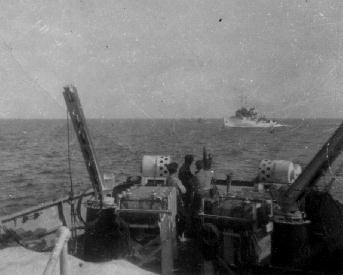by Ken Garrett
![]()
![]()
5th June, 1944It was the eve of D-Day and HMCS Algonquin was anchored half a mile from Ryde on the Isle of Wight. Captain Desmond Piers assembled the crew on deck and made a speech which has forever sunk into my memory.
"Tomorrow is "D" Day. There will be no leave tonight and I have the great honour to advise you we have been chosen to be in the spearhead of the invasion". Everybody groaned. "Now I have something to add to this. We will be at the point of the spear". This instant, we all had the undesirable feeling that tomorrow we might all be dead. My stomach felt like a bunch of feathers. It was the most awful feeling I ever had. In retrospect, we were quite lucky. The enemy only fired a few shells at us and because we were such a small target the shore batteries raised their guns and fired over our heads. What we thought was a huge disadvantage turned out to be the safest place to be.
Ken Garrett as he appeared on June 15th, 1942 during his service with the RCN.
As I stood there listening, I reflected on my career with the Royal Canadian Navy. It all started with my enlistment at HMCS Cataraqui in Kingston, Ontario on May 19th 1941. After basic training, a radar course at St. Hyacinthe Quebec and 12 weeks seamanship training in Halifax, I was posted to the radar maintenance office in Halifax where I repaired radar sets. In March 1942, when I was drafted to HMCS Kamloops K176, she just arrived from the west coast with all new crew on board. The "Jimmy" on the Kamloops noticed I was showing the ratings how to tie knots, throw a hand line, and do odd jobs, so he made me an instructor but there was no increase in pay. I did however, get out of washing dishes and scrubbing decks. One day, while on training exercises, the officers decided to drop a few depth charges for training purposes but forgot that the ship needed to steam a minimum of 14 knots. The resultant explosions, too close for comfort, cracked the ships rudder but the steering remained serviceable. A replacement rudder was simply not available since all rudder production was allotted to new ship construction only. The navy made a decision to station our ship in friendly waters where her safety would not be compromised. Kamloops was assigned to Pictou, Nova Scotia where her principal duty was to protect six Park-class merchant vessels which were being built there. The Germans has issued a threat that every ship built at Pictou would be sunk upon launching. Also stationed at Pictou was a British training submarine P512, complete with crew. Very often, the submarine acted as a target for the purposes of training ASDIC operators.
HMCS Kamloops was also hired to be a camera ship receiving $1000 a day for her work in filming the movie Corvette K225. For the movie, Fox Studios fabricated an extended foc'sle for K225, made from canvas. If you see the movie it's hard to believe it was made from this material. Later in the war, K225's foc'sle was extended and made from real steel. During the shooting of the film, Kamloops executed the entire repertoire of offensive and defensive manouevers that would be used in combat with the real enemy. When operations permitted, Kamloops also circled with the submerged P512 and made runs on her, but no depth charges were dropped. On days when there was no scheduled training, we were placed at the disposal of Fox Studios. Lt. John Rhodes Sturdie was the technical advisor for the K225 movie and also wrote the book. In total, he received $100,000 for his participation in the filming and the book royalties.After completing an advanced radar course at St Hyacinthe Quebec, I was posted to HMCS Algoma K127. During one escort run from Quebec City to Rigalet, Labrador, it took 8 days to sail down the St. Lawrence River, across the Gulf of St. Lawrence, through the Strait of Belle Isle, about 200 miles up the coast of Labrador and then to Rigalet. Here we anchored and our two oil tankers took gasoline to Goose Bay for the ferry command.
By a strange co-incidence I was in Quebec City while the Quebec Conference was being held. There, I heard the speech given by Winston Churchill, pledging two new 'V' class destroyers to Canada. One of these would become HMCS Algonquin and I never dreamed that I would one day become part of her crew. Algonquin commissioned on February 7, 1944. I didn't get a draft to the ship until early March since I was a last minute replacement for a senior radar rating who became seriously ill and had to be sent back to Canada. During the next few months, our ship faced extensive training to prepare us for the D-Day invasion, the greatest military armada ever launched against an enemy. Today I stood in deep thought reflecting on what that would mean to my well being and to my future.
Ken Garrett
LSR2 (Ret'd)
 |
This was an actual picture taken during the filming of K225 at Pictou, Nova Scotia.
| Back To Stories Index |